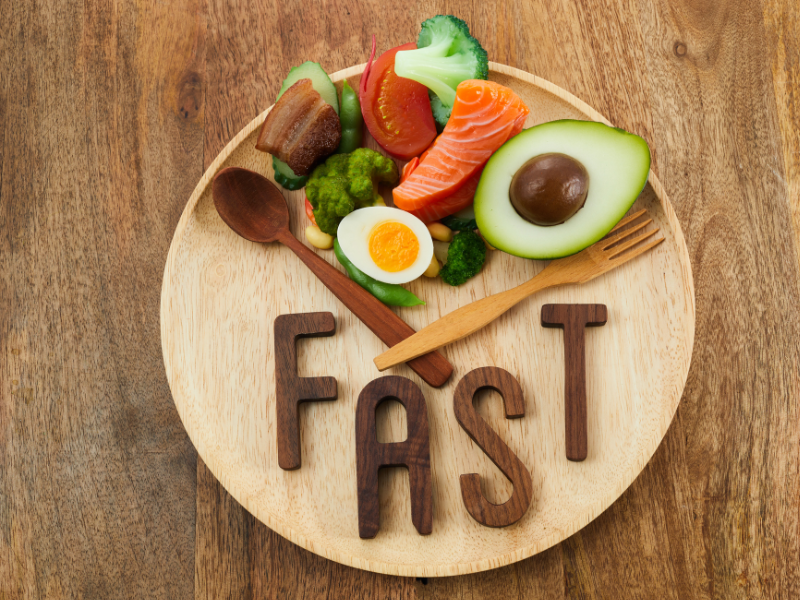


If you’ve been in the dieting game long enough, the term intermittent fasting is nothing foreign to you. However, there are so many different kinds of time-restrictive eating methods out there, which can make picking what suits you best a bit tricky. Because not all types of fasting are equal, and it’s important to choose the right one. This article covers everything you need to know about the 18/6 or 18:6 intermittent fasting schedule, its benefits, challenges, and the best tips to help you be successful in it. So read on to find out more!
What is 18:6 Intermittent Fasting?

Intermittent fasting (IF) involves a cycle of fasting and eating windows, and one of the many methods that fall under it is the 18:6 schedule. In this particular type of intermittent fasting, an individual fasts for 18 hours and then eats within a 6-hour window [1]. The most popular route that people go with is eating between 12 p.m. to 6 p.m., which generally means skipping breakfast and having an early dinner. During the fasting period, only beverages with no calories like water and black coffee are allowed to be consumed.
When compared to other methods of fasting, 18:6 can be viewed as more restrictive than 16:8 but not as strict as the OMAD diet or alternate-day fasting. By restricting the eating window to a mere 6 hours, it becomes challenging to consume more calories than the body needs, leading to naturally consuming fewer calories. This results in a calorie deficit that can facilitate weight loss. So, it can be categorized as an intermediate-advanced level in fasting approaches. It may not be ideal for beginners due to its long fasting windows, but it’s flexible enough to be worked into different personal schedules.
How does 18:6 intermittent fasting work?
So, how does the process of intermittent fasting work within the body? Now that there is a lack of food from the body due to fasting, your body shifts to burning stored fat instead. In general, glycogen is used as fuel for energy, but when it turns to stored body fat instead as the fasting goes on, it leads to fat loss. After a good period of time, the body then enters ketosis, where fat is converted to ketones for energy. By effectively shifting between glucose and fat for energy, the body’s metabolic health and flexibility also improve [1].
Learn more about intermittent fasting:
Intermittent Fasting by Age Chart: A Guide on How it Works
Intermittent Fasting Heart Disease Connection: What You Need to Know
How to Plan My 18:6 Intermittent Fasting Schedule

You must first start off by asking yourself the reasons why you want to do it, and then you can also go ahead with consulting a professional to have further confirmation on if the approach you’re taking is the right one for your needs. Once you’re ready to dive into it, you can follow the steps below to develop your new eating habits:
1. Pick your eating window:
Choose a 6-hour eating window that best coincides with both your professional and social life, but especially when you believe you might be physically or mentally exerting yourself the most so you need all the fuel you can get
2. Plan your meals:
Just because you can eat anything you want in your eating window, it isn’t wise to binge eat unhealthy or junk food. Make sure that you’re able to get all the nutrients you need with a healthy diet in the limited period of time that you have to eat and avoid overeating.
3. Give your body time to adapt:
Take time to understand your body and its needs, and don’t overestimate its capacity. It’s best to always start small, let’s say with perhaps a 14-hour fast, before slowly extending your time limit. You’re much more likely to fail in your endeavor if you were to dive head-first into something too challenging. The body and its metabolism will take time to adjust.
4. Hydrate yourself throughout
It is important to keep your hydration levels up, and this also helps with keeping your hunger pangs at bay. You can only have beverages with zero calorie value.
Benefits of 18:6 Intermittent Fasting
The following are some of the many health benefits of intermittent fasting [2]:

- Weight Loss: By limiting the eating window, fasting encourages fat burning and helps with calorie control, potentially helping one lose weight.
- Better Metabolism: Fasting improves insulin sensitivity and insulin resistance, supports fat burning, and boosts metabolic flexibility. This makes it easier for the body to switch between glucose and fat for energy.
- Heart Health: Reducing inflammation and aiding weight loss can enhance cardiovascular health and lower heart disease risk.
- Brain Function: Fasting increases ketone production, which enhances mental clarity and may offer protection against cognitive decline.
- Cellular Repair: Autophagy is activated, helping the body clear damaged cells, repair tissues, and possibly slow aging.
- Gut Health: Time-restricted eating supports a healthier gut microbiome, improving digestion and nutrient absorption.
- Reduced Inflammation: Fasting helps lower inflammation, which can protect against chronic diseases and support immune function.
Learn more about fasting:
How Much Weight Will I Lose on a 3-Day Water Fast?
How Long Can You Go Without Food?
Foods to Eat While 18:6 Intermittent Fasting

When you’re on the 18:6 intermittent fasting schedule, the magic happens not just with when you eat, but with what you eat. To get the most out of your fasting routine, aim for a balanced diet that’s full of wholesome, nutrient-rich foods. Here’s what to load up on during your eating window:
- Lean Proteins: Protein keeps you full and helps build and repair muscles. Think chicken, fish, tofu, legumes, and Greek yogurt to keep things balanced.
- Healthy Fats: These are your body’s energy boosters and brain food. Reach for avocados, olive oil, fatty fish, nuts, and seeds to fuel your day.
- Non-Starchy Veggies: Non-starchy vegetables like leafy greens, broccoli, cauliflower, and peppers are packed with fiber and antioxidants—your digestive system will thank you!
- Fruits and Whole Grains: Enjoy some sweet, satisfying fruits like berries and apples, and fuel up with whole grains like quinoa, brown rice, and oats for steady energy.
- Calcium-rich foods: Keep your bones strong with dairy or dairy alternatives like cheese, full-fat yogurt, or calcium-fortified plant milk.
Common Challenges and Risks

Of course, a diet that requires you to avoid consumption for a very long period of time involves risks. The obvious one is not giving in to hunger pangs and cravings while the body takes time to get used to prolonged fasting. You may also start to experience a dip in your energy levels, fatigue, or even brain fog while you’re trying to keep your hunger at bay [3].
Maintaining an 18:6 schedule can also be too long and restrictive to certain people’s lifestyles – it can clash with family meal times or social events, which can create a not-so-ideal atmosphere for the practicing individual. Since there’s only a 6-hour eating window, it’s best to load up your meals with the right calorie intake and all the essential nutrients you need, and this can be properly done when you have the time for meal prepping. Your new eating routine will also be a surprise to your stomach as it tries to digest your day’s worth of calories in a short time period, which might lead to digestive issues.
Who Shouldn’t Follow an 18:6 Intermittent Fasting Plan
The 18:6 intermittent fasting is not meant for everyone so it’s imperative to whether it suits your body’s needs before going for it. Individuals with the following concerns should not attempt it:
- People who are underweight or suffer from an eating disorder
- Pregnant or breastfeeding women
- Anyone with hormonal imbalances or irregular blood sugar levels
- Individuals suffering from chronic diseases and health conditions
- If you’re someone actively engaging in physical activity
Conclusion
The 18:6 intermittent fasting is a great method to try for weight loss, enhanced metabolic health, and a range of other health benefits – especially when paired with a balanced diet. However, it is considered to be an intermediate-advanced level dietary approach, so ensure you start things off slow and consult a doctor if you face any issues in the process. For more helpful tips and information on dieting and exercising, check out the JustFit app!





